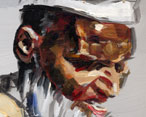Xenophilia
In praise of human variety

|
Graffiti (In Italian sgraffiti, in English graffiti, in America often mispronounced grafitti and spelled that way, and treated as a singular noun.) There are two kinds: those on interior walls of bathrooms, and those on exterior public surfaces. Those of the former kind deserve rarely amusement, usually contempt, and one of them was the most contemptible thing I have ever seen in writing (which is saying a lot). Altogether pleasanter is the architectural graffito, spray-painted on exterior surfaces—subways, abandoned buildings, bridges, hard-to-reach places alongside superhighways and railway tracks; composed of "fat letters"—maxfat letters, bulging up to and into each other, excluding space. The blocky letters may have shadows to suggest thickness, making them as ponderous as megaliths, or glints of white at their upper right corners to suggest shine, showing that their artists have learned at least something of the techniques of trompe-l'oeil. These graffiti presumably intend to emphasize some message, presumably contain names, yet insist on such an exaggeration of emphasis that they yield no recognizable names, no recognizable obscenities, hardly anything decipherable at all. I find them harmless and charming in their luxuriantly evolved stylization, both amusing and nightmarish in their obstinate and ingenious illegibility. Composed of letters, though letters buried in variation to the point of unrecognizability; yet one of the things about them that educators, at least, should admire is this worship of the written letter, a kind of intensified literacy, like that of the medieval scribe with the elaborated initial, a worship of A and E and L that lavishes itself in transformations for them and ways of mating them to each other. On the American train ride north, after the hill scenery ends are the graffiti to relieve the cities. They made me smile as the train ground into Washington or New York past half-subterranean expanses of gray concrete that would have frowned totally blank and grim if not relieved by these dreamlike exuberances. Only a pity that they passed into darkness in the tunnels, and that the train would not come to a stop by them—we passed them far too quickly to take them in! I hoped someone would come along and photograph them, for an art book, before some Municipal Chief Vandal had them painted over. On along past Baltimore and Trenton they brightened the worst concretescapes, some skifully fitted to rough stone or across corrugated metal; and through New Jersey, occasional railside cubes—little official housings for machinery—which on all four sides and the top were dense masterpieces, to rival the temple architecture of India. The official letterings of brewery or freight companies, higher up some of the same walls, were by contrast dead. Besides the round-fat-letter style and the sharpcornered-rambling-letter style and the colors and borders and three-dimensional planes, you begin to notice another style, groups of tapering strokes, the strokes reminiscent of Chinese and of the groupings of the tughra (the art of superimposing the characters of an Ottoman sultan's name in an indecipherably ornate swirl, such as only Arabic script lends itself to). Where did these various styles come from, all but inimitable, yet spread from city to city, a stylistic culture? In Manhattan itself, strolling near the train station, I discovered a feast of three giant graffiti on the brick side of an empty lot used for parking, off Eighth Avenue; I spent half an hour staring at them, trying in vain to analyze them, baffled even in the attempt to decide in what order the colors had been applied. One was nothing less than a brilliant compound maze. If that wallful is still there—or if you see any other such masterpiece—please photograph it for me and we can illustrate it here. All this was the expressive work of unemployed black kids. I would have liked to see them at work. You had to admire not only their artistry but their pluck in getting to inaccessible spots. The rage with which people at the opposite end of the social scale hate graffiti never ceases to surprise me. Someone caught perpetrating them was fined $3,233; firms spend thousands, and cities spend millions, to have them removed; Graffiti Control Services of San Bruno, California, developed "Graffiti Defenz", a coating from which graffiti could be easily wiped. In Sacramento, a city councilman, using the typical dehumanizing language of the repressor, proposed that the "gutless punks" who wrote graffiti should be publicly caned, as in Singapore. Another aspect of the mechanistic society's drive to stamp out anything spontaneous. However, a valid criticism of the fraternity of graffitists has been raised by the writer of a letter to Car Busters magazine (Jan.-Mar. 2005): "Why do kids spraypaint houses, and not cars? A big SUV offers a lot of surface area and their message would get carried around town the same way as with 'tagged' subway cars. Do graffiti artists have some kind of secret respect for cars? —Hartmut Stoltz, Stuttgart." Yes, I realize that this exposes the fallacy. Having to live with a house and car (despite serious efforts to live without them) I would not want them graffitoed. But for the concretescapes I would almost like graffiti to be commissioned, except that that would remove their spontaneity. |